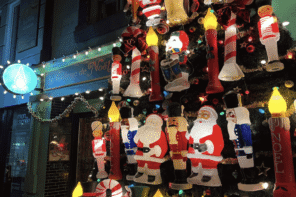While walking down the streets of Soho New York a week ago, I noticed common themes in the luxury store windows –red and gold colour schemes, Chinese lanterns, images of mice, and of course, big lettering spelling out “Happy Lunar New Year” both in English and Chinese — ‘tis the season for luxury brands to court Chinese customers.
According to the traditional Chinese calendar, January 25 marks the beginning of the Lunar New Year and this year, the Year of the Rat. This grand Lunar New Year holiday in China, called the Spring Festival, consists of 15 days of festivities. In a New Year’s custom almost as entrenched as eating dumplings or lighting fireworks, Western brands pay tribute to the zodiac’s 12 animals by pasting their cartoon forms over bags, clothes and accessories.
“the first thought that came into my mind was the “privilege” Chinese customers must be enjoying, as their cultural holiday is being acknowledged by these big retailers. Seeing an array of luxury retail boutiques, mixing their iconic styles with the symbols of the Chinese zodiac”
Given the strong spending power of the Chinese market, there’s ample motivation for Western brands to jump on the Chinese New Year bandwagon. (I mean, Chinese shoppers did spend more than a trillion yuan, that is $150 billion, across the holiday week last year.) This commodification of Lunar New Year isn’t anything new, but it has definitely become more and more popular among Western retailers in the past few years.
Walking past Louis Vuitton’s Soho boutique, the first thought that came into my mind was the “privilege” Chinese customers must be enjoying, as their cultural holiday is being acknowledged by these big retailers. Seeing an array of luxury retail boutiques, mixing their iconic styles with the symbols of the Chinese zodiac– very auspicious in red and gold — I started to wonder what Chinese shoppers’ views are on this commodification of the biggest holiday of the year.
“Lunar New Year has become an opportunity for retailers to sell their products under the guise of ‘honouring’ the cultural celebration.”
According to a Toronto-based fashion, beauty and lifestyle writer, Madelyn Chung, “seeing these brands attempting to appeal to the Chinese market doesn’t sit well with [her].” She says, “after all, they’re not Asian brands and their half-hearted attempts to lure Chinese customers into their stores seem desperate at best.” Chung believes that these Western brands don’t truly appreciate the meaning of Chinese New Year. The fact that the majority of them can’t even hire Chinese artists to design and produce these products, and as such, literally appropriate ancient artforms rich in symbolic meaning? That’s a problem. This type of Lunar New Year merch no longer makes her and other Chinese customers feel as though their culture is being acknowledged;instead, it makes them feel like it’s being exploited for money.
Indeed, as with most holidays, Lunar New Year has become an opportunity for retailers to sell their products under the guise of “honouring” the cultural celebration. While there are various other lunar-based celebrations in the months that follow, Western fashion houses have notably latched onto Lunar New Year due to the scale of its celebration. Every year, they are given the opportunity to create new merchandise that correlates with the 12 animals of the Chinese zodiac, each of which symbolizes a given year. A person’s zodiac sign depends on their birth year, and even American consumers have a semblance of knowledge of the zodiac. Given our collective enthusiasm for identifying ourselves through unscientific, ambiguous ways, brands rely on zodiac imagery to sell their products.
“Criticism of international luxury brands from Chinese consumers was something of a theme throughout 2019: it left companies scrambling to scrape together corporate apologies and has soured China’s perception towards Western brands.”
Obviously, these luxury retailers need to do their homework and understand cultural practices when promoting any holiday. It is important for brands to be respectful of cultural codes during Lunar New Year, as well as to ensure their message will reach the Chinese consumers on the right social platforms. After a number of cultural shocks, all of the international brands are playing it safe this Chinese New Year. Criticism of international luxury brands from Chinese consumers was something of a theme throughout 2019: it left companies scrambling to scrape together corporate apologies and has soured China’s perception towards Western brands. In 2019, Burberry released its first-ever Lunar New Year ad on the Chinese social media app, We Chat. However, the ad, which resembled a somber-looking family portrait, was widely labelled “creepy,” for misinterpreting the festive nature of the holiday.
Burberry was not alone in causing Chinese consumers to have high expectations for cultural sensitivity from brands. A short while later, Bvlgari found itself in the middle of a wordplay controversy when it released its Chinese New Year ad on WeChat and accidentally linked Jewish culture with pigs to welcome the new year. Brief explainer: In Mandarin, the word “pig” is pronounced “zhu” which is similar to the pronunciation of Jew in English. The Bvlgari campaign headline meant to say, “Be my bright pig in the palm,” a funny way to showcase its jewellery and watches, but instead directly translated to “Be my bright JEW in the palm.” Both Burberry and Bvlgari swiftly removed their campaigns from the app, and for good reason.
The sequence of brand missteps that happened last year cannot be duplicated this year. It is clear how hard Western fashion houses are trying to play it safe this year, courting Chinese customers on tiptoes: the upcoming “Rat Year” has proven to be something of a boom for The Walt Disney Company, with its endearing rodent mascot representing a safe way for brands to pay tribute to the Chinese Lunar New Year, without being too serious or controversial.
One may not see this commercialization of Chinese New Year as problematic; perhaps there is nothing inappropriate about sharing one’s culture by marketing during holidays and in doing so, targeting the specific culture that celebrates it. For me and to many others, however, relegating a meaningful celebration to gimmicky products isn’t good business. Using colours, symbols and imagery is not sharing; it is showcasing faux-pas that ranges from off-brand imagery to offensive wording. Despite their best efforts to tiptoe around Chinese consumers, Western retailers cannot escape the criticism that will inevitably follow capitalizing on this traditional festive holiday without a semblance of understanding the culture.








